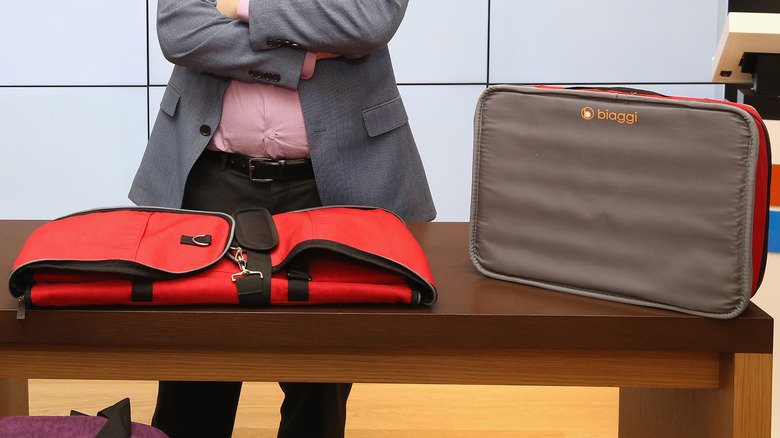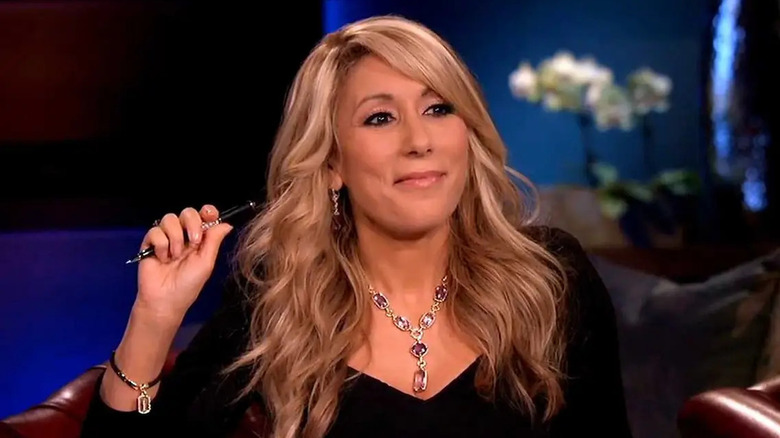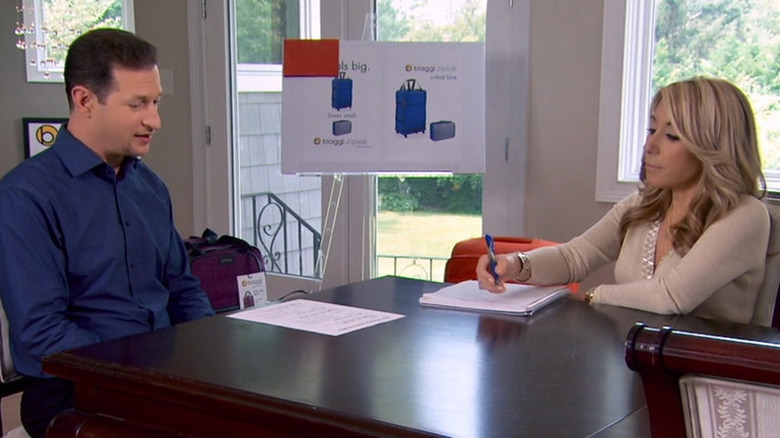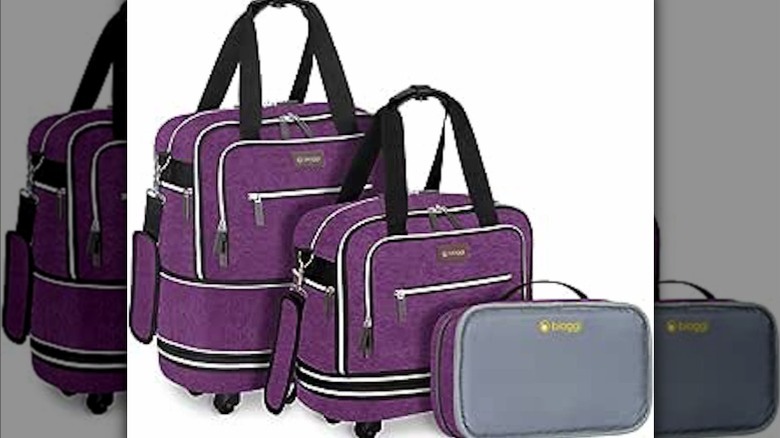What Really Came Of Biaggi From 'Shark Tank?'
We may receive a commission on purchases made from links.
It goes without saying that good luggage is essential for many travelers, but what about the space it takes up between trips? Stephen Hersh from Brooklyn had an ingenious solution when he entered the "Shark Tank" in 2014, ABC's stateside version of the popular U.K. reality show "Dragon's Den." With his calm and engaging personality, Hersh pitched his range of attractive Biaggi foldable luggage, placing an emphasis on its space-saving capabilities when not in use.
Hersh hailed from a family that already had significant expertise in bag design. His father, Ron, had already sold his company Rosetti Handbags & Accessories for $162 million, and the family had already plowed a significant stake into Hersh Jr.'s new venture, designing a smart and innovative luggage solution that collapsed to a fraction of its size.
Hersh gave an assured pitch and was disarmingly candid about the teething problems his company faced, a factor that clearly endeared him to all five of his potential investors. Nevertheless, three sharks dropped out of the running, leaving only two sharks — Daymond John, who made his millions with his FUBU range of hip-hop apparel, and Lori Greiner, the prolific retail innovator with over 120 patents to her name — with an interest in Hersh's product. Both came in with identical offer, but John was determined to put pressure on the luggage designer. What happened next was pure "Shark Tank" drama.
What happened to Steve Hersh on Shark Tank?
Steven Hersh arrived on "Shark Tank" asking for an investment of $500,000 in return for 30% of his company Biaggi, into which his father and business partner had already sunk $3.5 million. He proceeded with a slick presentation that demonstrated the innovative qualities of his luggage. The star of the show was the Zipsak, which transformed from a small gray pouch to a large four-wheeled suitcase.
Hersh was refreshingly honest about the problems that Biaggi faced. One of the biggest challenges was "customer education," as stores carrying the luggage often failed to fully highlight the space-saving potential of the brand. That prompted Hersh to pause production, putting financial strain on the company as the team figured out how to tackle the PR issue.
With three sharks already declining to make Hersh an offer, Daymond John took an aggressive stance. He agreed to stake the full amount for 33% of Biaggi, but only gave the entrepreneur 20 seconds to decide. Lori Greiner also expressed a clear interest, but John called time before she got around to making an identical competing offer. As a sweetener, she also promised to get the luggage on QVC within four months.
This left Hersh with a tough decision and he stepped out of the room to call his dad for advice. Meanwhile, John had a surprising change of heart. Appreciating that Greiner's expertise was better suited to helping Hersh's business, he gracefully stepped aside.
Biaggi after Shark Tank
Lori Greiner's money and influence quickly had a positive effect on Steven Hersh and Biaggi's fortunes. She identified the Zipsak as the "hero" of the brand and, true to her word, got Hersh and his luggage on QVC. She even took to the shopping channel herself to demonstrate the ingenious foldaway bag, making it an instant best-seller. Combined with Hersh's appearance on "Shark Tank" and hands-on backing from his benefactor, the effects were also apparent on the balance sheet, with Biaggi's revenue leaping from $40,000 in 2014 to $3 million in 2015.
Hersh and his company generated considerable media interest through 2016 and, in the same year, he appeared on Season 2, Episode 2 of "Beyond the Tank," ABC's follow-up show that revisited some of the stars of "Shark Tank." Buoyed by his recent success, Hersh talked about building a "luggage empire" and boldly returned to his original baby — the Contempo line, which Greiner had advised shelving to focus on his best-seller. Greiner looked visibly dismayed to learn that he had shelled out $500,000 to order almost 11,000 units of a product she considered too bulky and expensive.
Unable to convince his investor of Contempo's marketability, Hersh was left with a whole bunch of stock to shift without her clout behind it. Nevertheless, she was enthusiastic about the lightweight Fashion Tote unit, which became the basis for the Zipsak Boost, which is still Biaggi's flagship product.
Is Biaggi still in business?
Since Steve Hersh's appearances on "Shark Tank" and "Beyond the Tank," the popularity of Biaggi's foldable range has been further boosted by major outlets like USA Today and Huffington Post.
Biaggi maintains a strong presence on social media, interacting with customers and commenters with the same engaging tone as Hersh struck during his successful pitch on "Shark Tank." Despite the significant boom in revenue, the company has maintained the feel of a family business. At the time of his Forbes interview in 2016, Hersh was still running Biaggi with two employees and the help of a third-party fulfillment center, which was his biggest expense.
It hasn't been all plain sailing for Biaggi. While the updated Zipsak Boost is still receiving some rave reviews in 2023, consumers on Amazon.com only give it a 2.9 rating on average, with many negative reviewers citing poor design quality and awkwardness of use. The consumer advice site ThisButNotThat also listed Biaggi among their luggage brands to avoid due to the same issues combined with a relatively high price tag.
Nevertheless, Hersh and Biaggi are still going strong. As of August 2023, RocketReach said the company was bringing in around $4 million in annual revenue, and it is currently promoting a wide variety of products for the space-conscious traveler.



